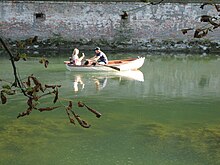Augsburg boat trip

The Augsburger Kahnfahrt is a leisure facility with a restaurant and beer garden in Augsburg . The privately owned boat rental has a tradition that goes back to the 19th century and uses the water in the moat in the historic Jakobervorstadt district of Augsburg .
history

In the 1870s, the entrepreneur Paul Kurz decided to create a leisure activity with small boats on the wide expanse of water of the Augsburg city moat near the Oblatterwall , which he rented out to interested parties for a short time. On May 1, 1876, he opened his business with three barges in front of the city wall of the northern Jakobervorstadt. His idea was successful. Especially in the summer months, the audience was given the opportunity to relax or find a change in everyday life with a rowing party.
In 1901, the Augsburg architect Karl Albert Gollwitzer , who had a navigable connection between Augsburg over the Lech and the Danube to the Black Sea, wanted to include the Kahnfahrt site in a port. His vision of the “Augsburg Canal Harbor” was viewed with a lot of ridicule and ultimately not realized.
In the 1910s, the idyllic spot in the big city often attracted Bertolt Brecht and his friends, who lived close to his parents' house by the moat . The future poet mentioned the Kastanienallee along the boat trip in his essay On Viewing My Early Pieces .
During the Second World War , the air raids on Augsburg in 1944 also caused severe damage to the urban canal system. As a result, the flow of water into the city moat had to be stopped. This lay dry for a few years until after the war and was used as a cow pasture during that time . After the damage had been repaired, the trench was filled with water again and the boat trip began again. This was the only interruption since the boat trip was founded.
Initially wooden boats for renting boats were available as pedal boats or rowing boats , but plastic boats have been in use since the 1980s, some of which are also designed as electric boats and are electrically powered.
If the water surface freezes over in winter and the ice is thick enough, ice skating or curling are possible.
The dining facilities on the boat trip include a beer garden , the majority of which are located directly on the water, and a restaurant .
location
The area of water on which boats can be rowed is located directly in front of the preserved remains of the old city wall on the Oblatterwall and its tower. The round bastion marks the northeast tip of Jakobervorstadt. The aforementioned Kastanienallee runs on the opposite side. A guardrail separates the pedestrian walkway along the street from the water surface. If necessary, strollers can take a breather on some of the benches and watch the boats. The boat trip uses the waters of the outer city moat branching off at the Vogeltor . This body of water joins the inner city moat, which leads from the bird gate to the lower moat, below the Schwedenstiege, which is close to the boat trip .
literature
- Martha Schad : Augsburg compact. The handy city guide. Updated new edition. Wißner, Augsburg 2009, ISBN 978-3-89639-691-4 , p. 5.
Web links
- Restaurant for the boat trip
- Augsburg boat trip in the Augsburg Wiki
- Punting Augsburg: Historical Pictures
Individual evidence
- ↑ Schwabenmedia.de: Kahnfahrt Augsburg , queried on August 27, 2010
- ↑ augsburger-stadtlexikon.de: Oblatterwall ( Memento of the original from March 4, 2016 in the Internet Archive ) Info: The archive link was inserted automatically and has not yet been checked. Please check the original and archive link according to the instructions and then remove this notice. , accessed on August 27, 2010
- ^ Jürgen Hillesheim: Augsburger Brecht Lexicon: People, institutions, scenes . Königshausen & Neumann, Würzburg 2000, ISBN 3-8260-1276-3 , p. 45–46 (192 p., Limited preview in Google Book search).
Coordinates: 48 ° 22 ′ 31.1 ″ N , 10 ° 54 ′ 19.9 ″ E
